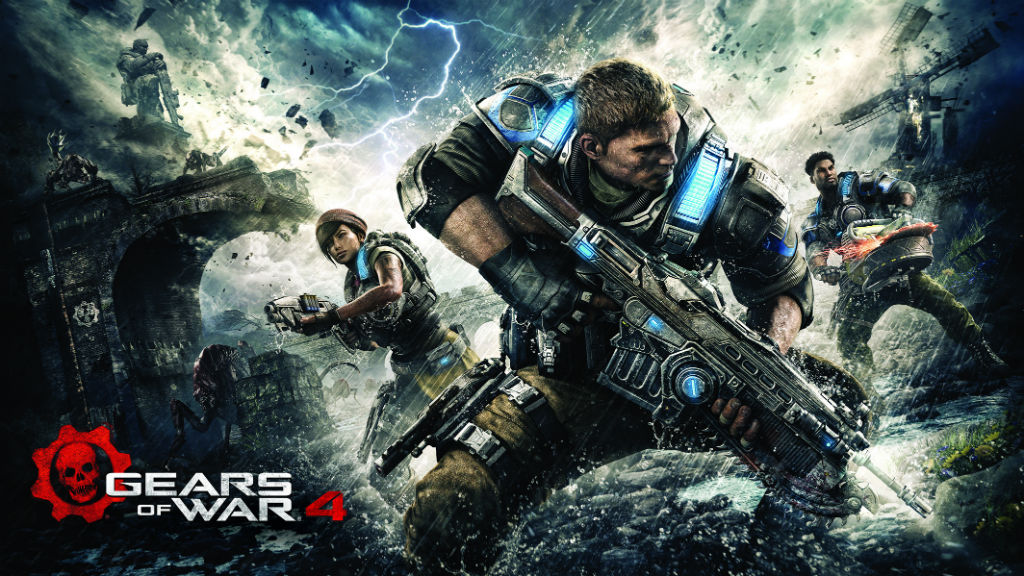
New story, new heroes, and the dawning of a terrifying new era; this is Gears of War 4 on Xbox One. While there are a lot of fresh elements to be very excited about in this latest mainline entry of Microsoft’s flagship franchise, at its core, this is still very much the Gears of War we all know and love. I’m talking about phenomenal cover-based gameplay, brutal, visceral combat, and world-class online multiplayer modes—all powered by the latest and greatest game engine, in this case, Unreal Engine 4.
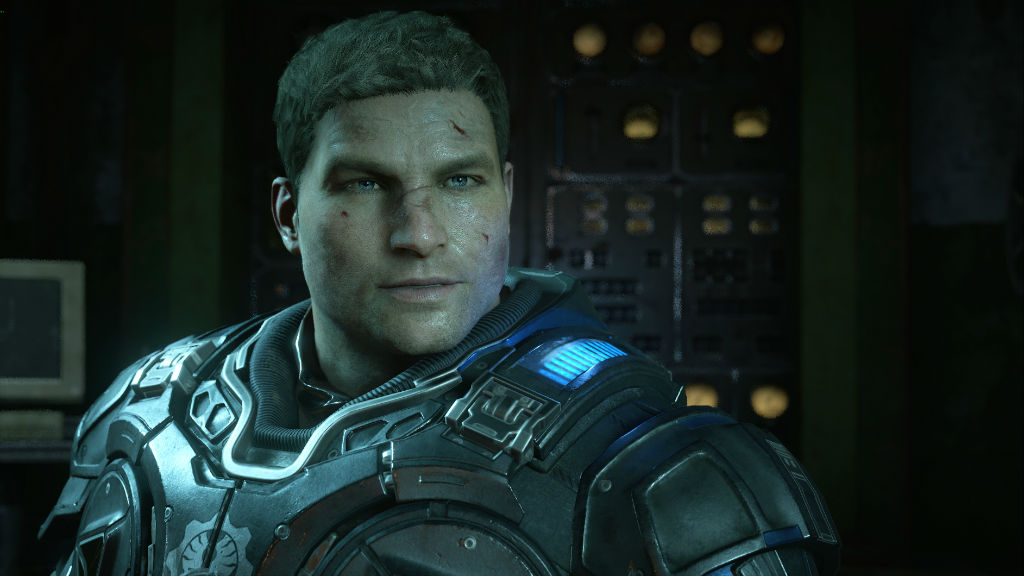 New owner, new developer
New owner, new developer
Following the modestly underwhelming Gears of War: Judgment in 2013, fans were understandably asking questions about the future of this massively popular third-person shooter series—feelings that only amplified when Microsoft announced, mere months later, they had acquired the franchise rights from Epic Games. Fans were naturally asking where the franchise would go next, especially since Microsoft announced that Vancouver-based Black Tusk Studios (later renamed The Coalition), a relatively new and unproven studio, would be the new steward for the franchise. There was good reason for optimism though, since Rod Fergusson, the former Epic Games executive producer who oversaw the Gears of War trilogy, was hired by Microsoft to play a key leadership role in the franchise going forward.
After spending quite a bit of time now with Gears of War 4, the first entry of an all-new Gears trilogy, one thing I can say for certain is Fergusson and his team delivered. It won’t be winning the best in the series award (that distinction still belongs to Gears of War 2, in my books), but it’s an incredible game overall, and diehard fans are sure to enjoy it. Being that Gears 4 is the start of a brand new story, and the first original Gears game developed for Xbox One, it’s is also the perfect starting point for newcomers to the series. New fans may also want to check out last year’s superb Gears of War Ultimate Edition to see how this legendary franchise began.
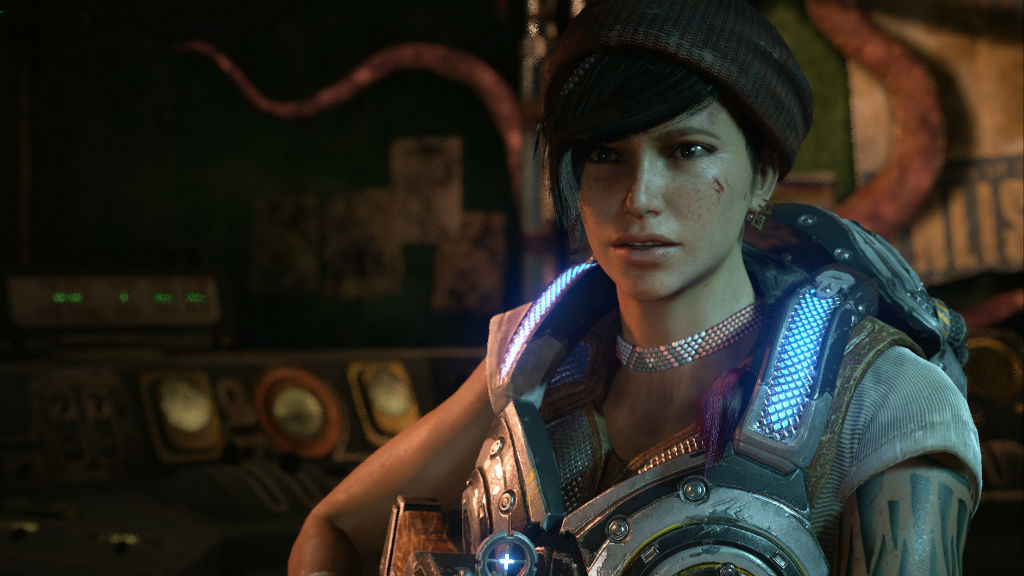 Platform(s): Xbox One
Platform(s): Xbox One
Release Date: October 11, 2016
Developer: The Coalition
Publisher: Microsoft Studios
Genre: Third-person shooter
Modes: Single-player, multiplayer
ESRB Rating: M (Mature, 17+)
Sera, 25 years later
The campaign in Gears of War 4 kicks off with a slick prologue chapter where the leader of the reformed Coalition of Ordered Governments, First Minister Jinn, commemorates the 25th anniversary of the end of the Locust War by recounting the pivotal war stories of years past. In a neat twist, you actually get to experience these crucial moments, through playable mini-mission, which shaped the lives of the citizens of Sera; namely, the Pendulum Wars, Emergence Day, and the deployment of the Imulsion Countermeasure weapon. For Gears of War newbies this chapter serves a nice crash course explaining the most important events of the original trilogy, and for veteran fans, it’s a wonderful trip down memory lane.
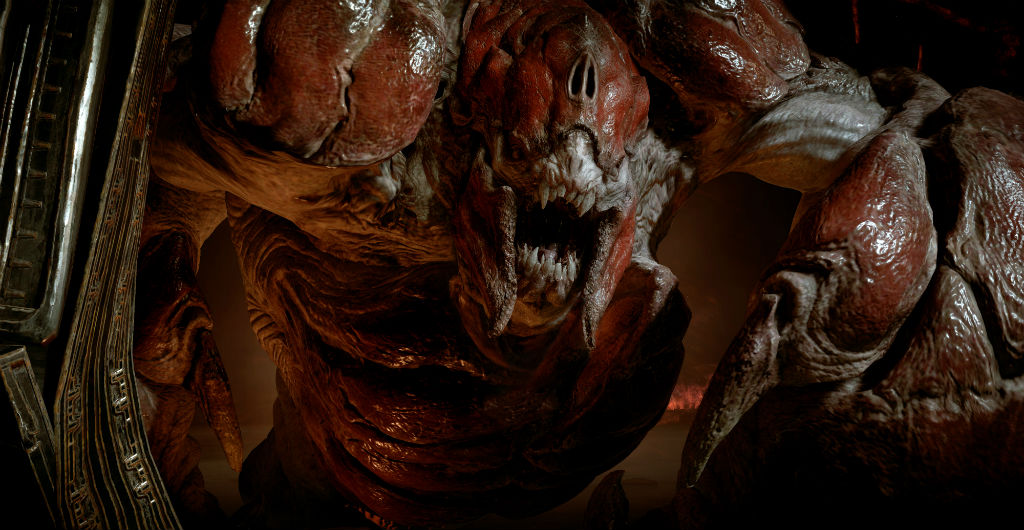 Soon thereafter we get introduced to a new cast of heroes, specifically, JD Fenix (son of Marcus Fenix and Anya Stroud), Delmont “Del” Walker, and Kait Diaz, who are all living in an “Outsiders” settlement, away from the oppressive COG regime and their hardline approach to rebuilding/repopulating the planet. At least initially, the tone of game is much different from past Gears campaigns, as we’re shown numerous beautiful images of Sera undergoing healing and rebirth, but this serenity is short-lived following the mysterious disappearance of COG citizens from their heavily protected walled cities. Jinn blames the Outsiders for these kidnappings, but our heroes discover a much more terrifying explanation: a new breed of monsters, which they dub The Swarm, has emerged.
Soon thereafter we get introduced to a new cast of heroes, specifically, JD Fenix (son of Marcus Fenix and Anya Stroud), Delmont “Del” Walker, and Kait Diaz, who are all living in an “Outsiders” settlement, away from the oppressive COG regime and their hardline approach to rebuilding/repopulating the planet. At least initially, the tone of game is much different from past Gears campaigns, as we’re shown numerous beautiful images of Sera undergoing healing and rebirth, but this serenity is short-lived following the mysterious disappearance of COG citizens from their heavily protected walled cities. Jinn blames the Outsiders for these kidnappings, but our heroes discover a much more terrifying explanation: a new breed of monsters, which they dub The Swarm, has emerged.
Fatherly help arrives
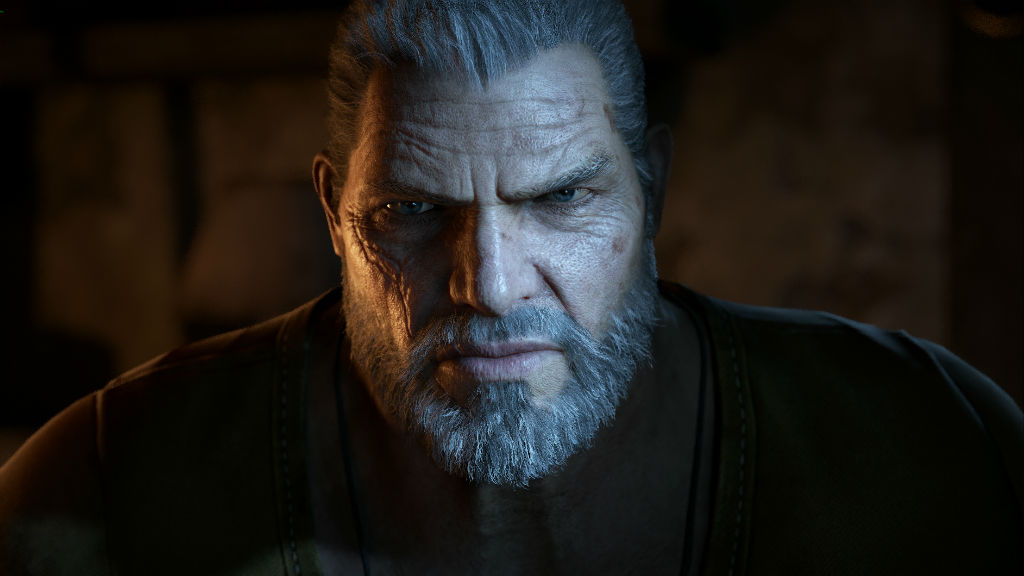 From here on in the story takes a dark, horrific turn, as our heroes uncover the true scale of this new threat, very much reminiscent of the original Gears of War. Unlike that game though, these new heroes are much more down-to-earth and relatable, often cracking jokes even in the heat of battle, and possessing none of the “dude bro” machismo we saw with Marcus Fenix and the gang. As much as I enjoyed the lighthearted banter between the newer cast, once Marcus Fenix gets introduced to the story I suddenly realized how much I missed the hardened, stoic soldier mentality the franchise is synonymous for. Seeing Marcus’ tough-as-nails attitude and decisiveness in the face of adversity brought back a flood of fond memories, and really stood in contrast to JD and his crew, who come off as inexperienced and wishy-washy by comparison. It’s hard to fault the newer cast for their unpreparedness, though, since this is the first time in their life they’ve ever had to face something as menacing and life-threatening as The Swarm. Still, it would have been nice to JD stand on his own two feet more, instead of leaning so heavily on good ol’ dad, who basically holds the entire story together.
From here on in the story takes a dark, horrific turn, as our heroes uncover the true scale of this new threat, very much reminiscent of the original Gears of War. Unlike that game though, these new heroes are much more down-to-earth and relatable, often cracking jokes even in the heat of battle, and possessing none of the “dude bro” machismo we saw with Marcus Fenix and the gang. As much as I enjoyed the lighthearted banter between the newer cast, once Marcus Fenix gets introduced to the story I suddenly realized how much I missed the hardened, stoic soldier mentality the franchise is synonymous for. Seeing Marcus’ tough-as-nails attitude and decisiveness in the face of adversity brought back a flood of fond memories, and really stood in contrast to JD and his crew, who come off as inexperienced and wishy-washy by comparison. It’s hard to fault the newer cast for their unpreparedness, though, since this is the first time in their life they’ve ever had to face something as menacing and life-threatening as The Swarm. Still, it would have been nice to JD stand on his own two feet more, instead of leaning so heavily on good ol’ dad, who basically holds the entire story together.
Exciting moment, new dangers
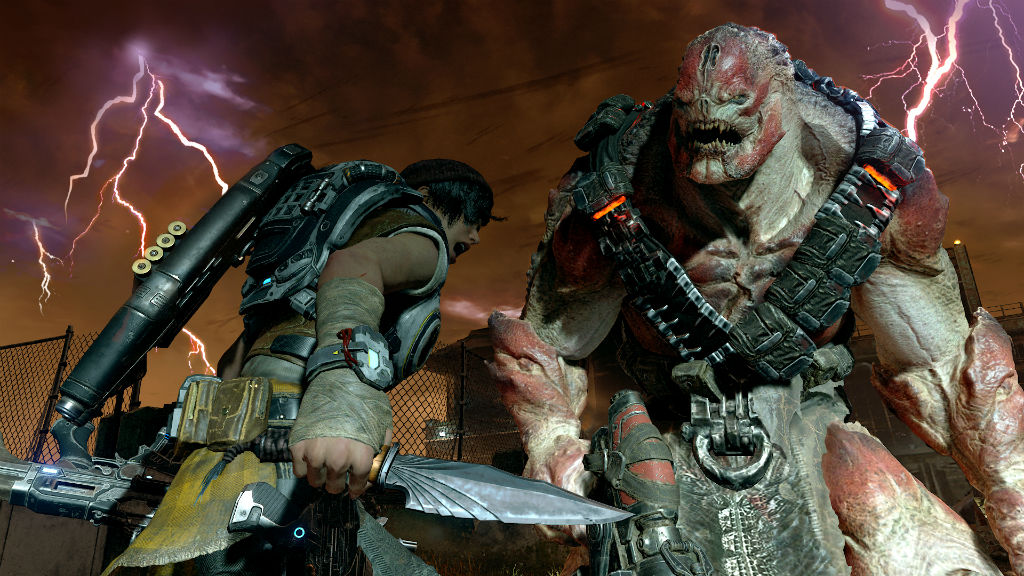 As you’d expect from a Gears of War campaign, you’ll encounter a number of set piece moments including intense cover-fire gunfights, epic boss battles, and a few other surprises along the way. You’ll also have to contend with violent Windflares—a new natural phenomenon caused by the Immulsion Countermeasure—which can strike the ground with forceful electrical surges, as well as rip apart large objects and send them hurling across the battlefield. Windflares also affect the trajectory of grenades and other projectile weapons, forcing you to adapt quickly to ever-changing situations and prompting you to seek shelter as fast as possible.
As you’d expect from a Gears of War campaign, you’ll encounter a number of set piece moments including intense cover-fire gunfights, epic boss battles, and a few other surprises along the way. You’ll also have to contend with violent Windflares—a new natural phenomenon caused by the Immulsion Countermeasure—which can strike the ground with forceful electrical surges, as well as rip apart large objects and send them hurling across the battlefield. Windflares also affect the trajectory of grenades and other projectile weapons, forcing you to adapt quickly to ever-changing situations and prompting you to seek shelter as fast as possible.
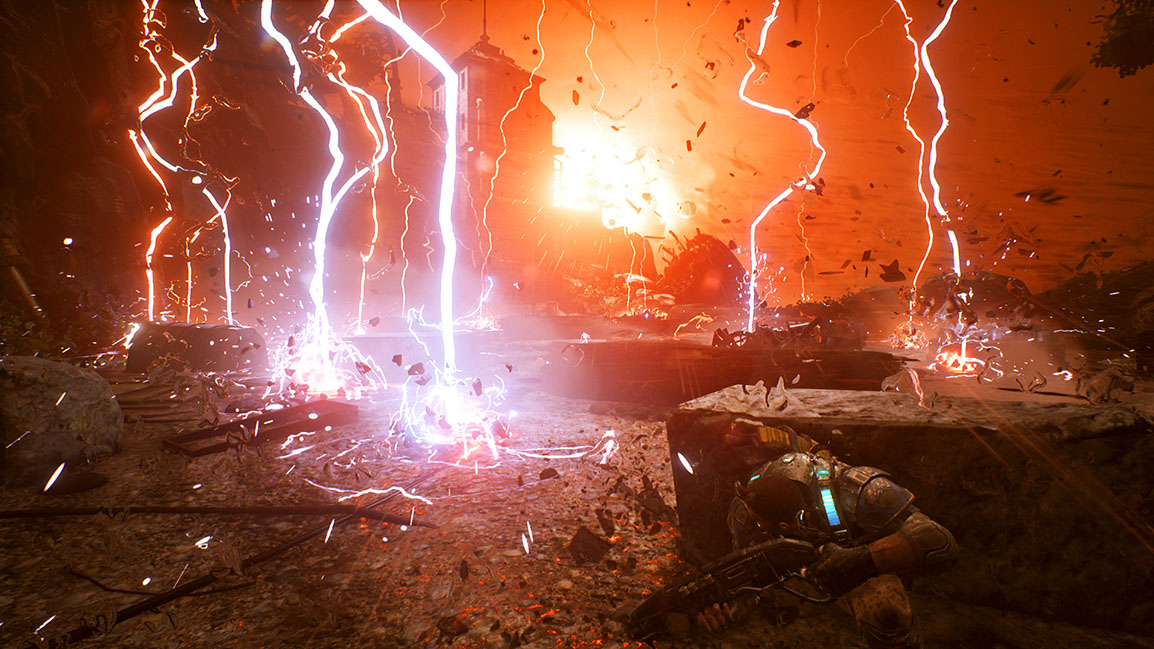 The campaign also includes enjoyable scenarios that task you with combating waves of enemies using the same set-up and rules as the game’s enhanced Horde 3.0 mode. Here you’ll need to use a device called the Fabricator to deploy defenses, including floor spikes and portable turrets, as you prepare for increasingly tougher Swarm waves. As you defeat enemies, you’ll obtain a currency known as “Power,” which you’ll spend the following round to purchase new defenses. Given how awesome the Horde 3.0 mode is, these moments were by far my favourite in the entire campaign. My only complaint, overall, is the campaign’s abrupt ending that leaves several important plot threads unanswered and doesn’t fill you a strong sense of accomplishment. Likely these dangling loose ends were done on purpose to make us anticipate the next couple of chapters in the trilogy even more, but that’s a tough pill to swallow knowing it’ll be likely be 2-3 years before we can play the next game.
The campaign also includes enjoyable scenarios that task you with combating waves of enemies using the same set-up and rules as the game’s enhanced Horde 3.0 mode. Here you’ll need to use a device called the Fabricator to deploy defenses, including floor spikes and portable turrets, as you prepare for increasingly tougher Swarm waves. As you defeat enemies, you’ll obtain a currency known as “Power,” which you’ll spend the following round to purchase new defenses. Given how awesome the Horde 3.0 mode is, these moments were by far my favourite in the entire campaign. My only complaint, overall, is the campaign’s abrupt ending that leaves several important plot threads unanswered and doesn’t fill you a strong sense of accomplishment. Likely these dangling loose ends were done on purpose to make us anticipate the next couple of chapters in the trilogy even more, but that’s a tough pill to swallow knowing it’ll be likely be 2-3 years before we can play the next game.
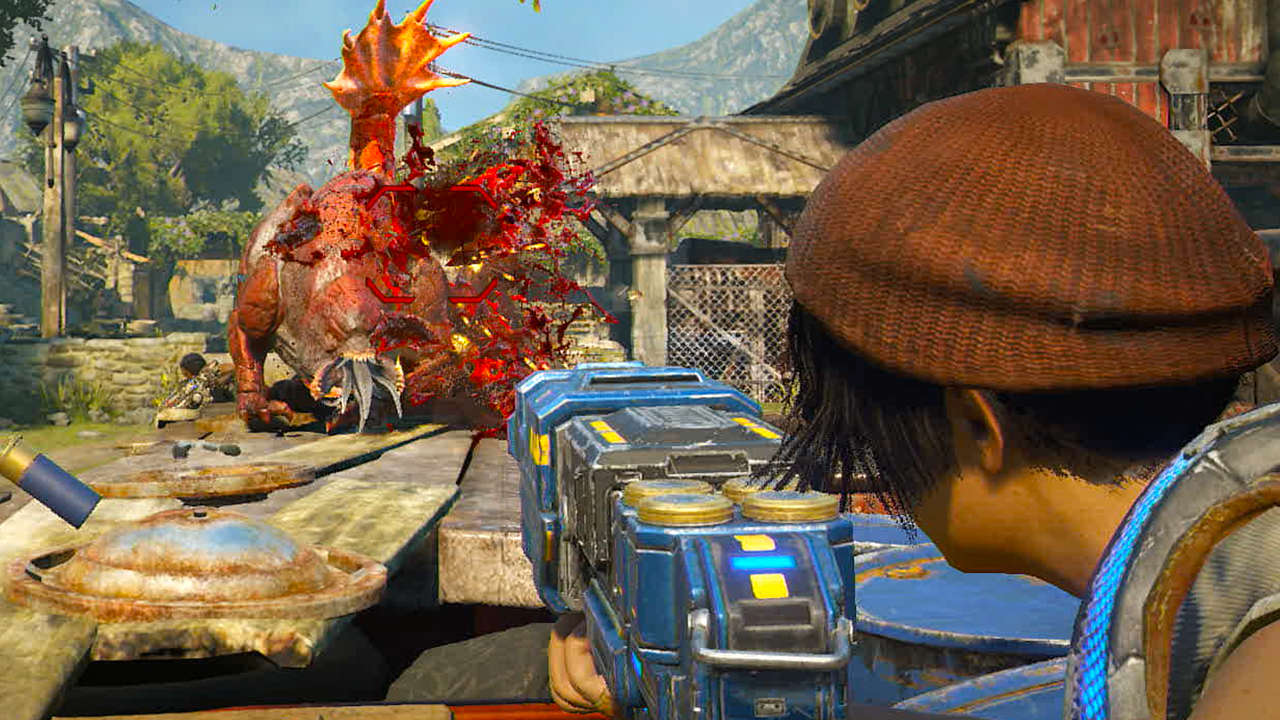 Horde 3.0
Horde 3.0
As much as I enjoyed the game’s main story, the real reason to pick up Gears of War 4, in my opinion, is the incredible new Horde mode. My favourite Gears mode is back and better than ever with a new class system, new card system, and tons of gameplay improvements. The basic premise is this: up to five players online can take on 50 waves of increasingly difficult enemies, with a boss battle every 10 waves, after which your team will disadvantaged with a new “poison” such as enemy’s dealing x2.0 damage, or possessing x2.0 accuracy. I love the new class system where you can choose between playing as a Soldier, Scout, Heavy, Sniper, or Engineer, each having their own starting loadout and special abilities. Soldiers are for those who prefer traditional Gears gameplay focusing on cover-fire, grenades, and Lancers; Scouts primary goal is to collect Power for the team; Heavies are the only class that begins with a power weapon; Snipers, well they snipe; and Engineers specialize in building and repairing defenses.
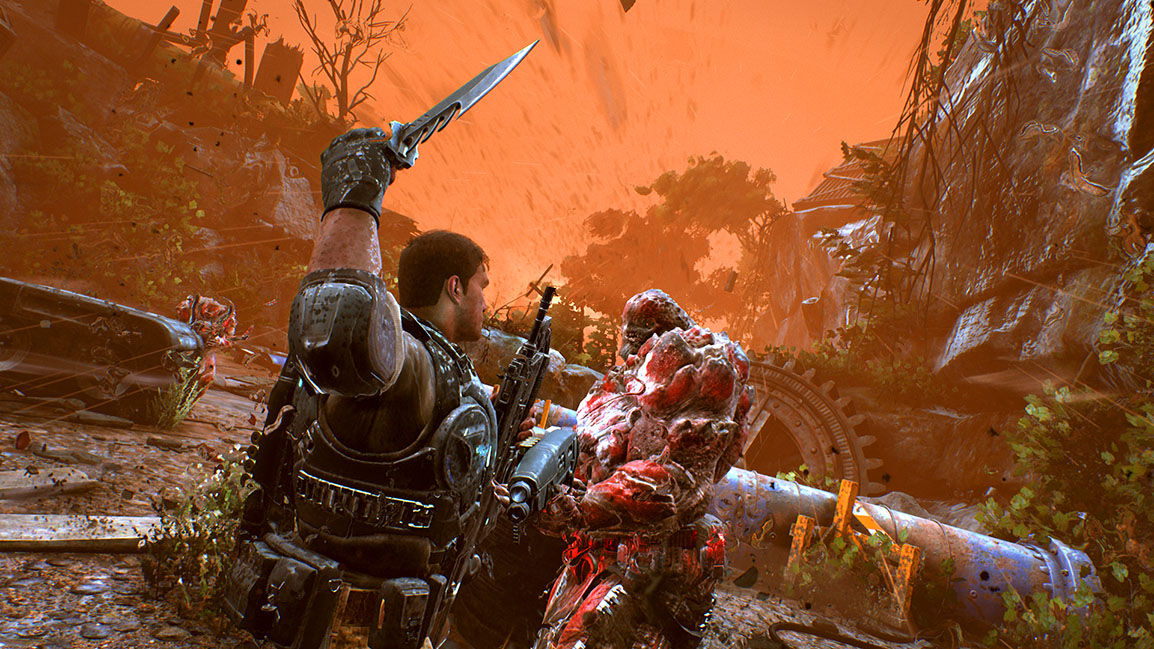 Early on, the only real differentiator between the classes is their loadouts, but once you accumulate Gears Cards that unlock specific class skills, the classes really begin to show their strengths. Scouts, for example, can gain huge max health and health regeneration bonuses, making them near unstoppable on the battlefield as they scramble to collect Power. Snipers, on the other hand, can dramatically increase their headshot damage, and even make heads explode to damage nearby enemies. Engineers, the backbone of the team, gets cards that reduce the cost of building or repairing fortifications, letting you preserve more precious Power for when the team really needs it. The one drawback to the card system? It takes hours of game time to upgrade skills, though you can choose to spend real money for faster upgrading.
Early on, the only real differentiator between the classes is their loadouts, but once you accumulate Gears Cards that unlock specific class skills, the classes really begin to show their strengths. Scouts, for example, can gain huge max health and health regeneration bonuses, making them near unstoppable on the battlefield as they scramble to collect Power. Snipers, on the other hand, can dramatically increase their headshot damage, and even make heads explode to damage nearby enemies. Engineers, the backbone of the team, gets cards that reduce the cost of building or repairing fortifications, letting you preserve more precious Power for when the team really needs it. The one drawback to the card system? It takes hours of game time to upgrade skills, though you can choose to spend real money for faster upgrading.
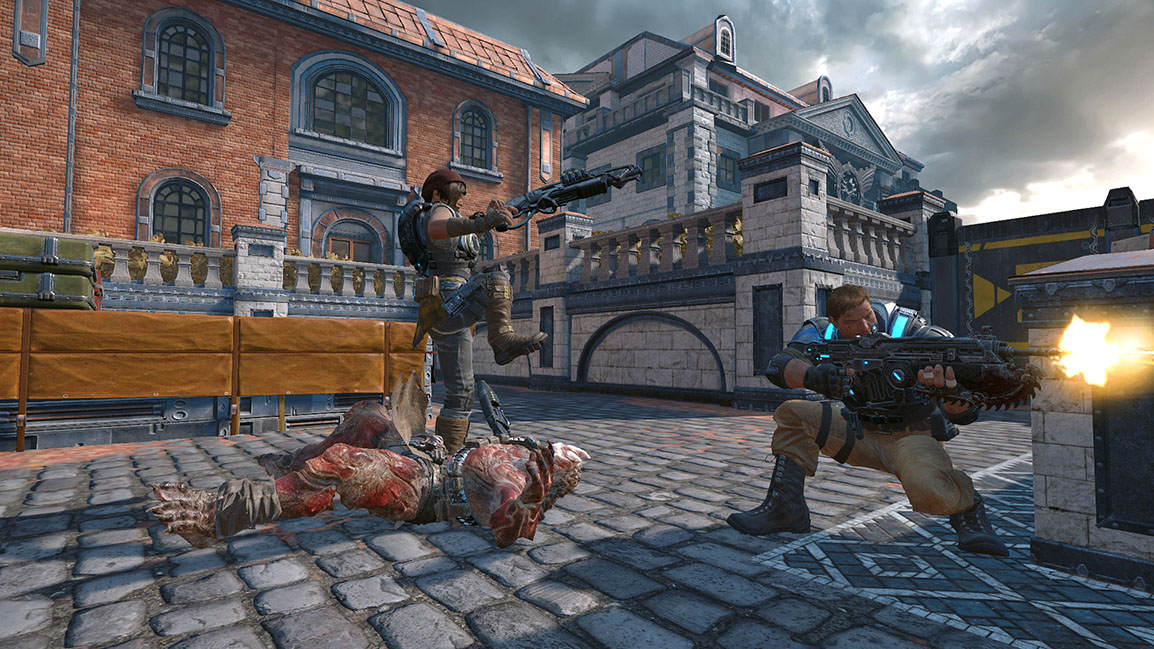 Ten different maps are playable in Horde 3.0—the same ten used in the Versus Multiplayer mode—including nine new maps and the mandatory inclusion of Gridlock. Most maps are symmetrical and offer tons of strategic locations to deploy the mobile Fabricator used to purchase all your defenses. During Horde mode all weapons can be obtained from fallen enemies (or purchased in the Fabricator), including fan-favourites like the Gnasher Shotgun, Lancer, Longshot Sniper Rifle, and more. There are so many awesome new weapons to use too, with my top choice being the deadly Overkill double barrel shotgun that will stop nearly all enemies at short range. There’s also great new weapons like the Buzzkill, a heavy weapon firing ricocheting sawblades, the EMBAR, a charge-shot sniper rifle, and the Dropshot, a mining tool that drops explosive drills.
Ten different maps are playable in Horde 3.0—the same ten used in the Versus Multiplayer mode—including nine new maps and the mandatory inclusion of Gridlock. Most maps are symmetrical and offer tons of strategic locations to deploy the mobile Fabricator used to purchase all your defenses. During Horde mode all weapons can be obtained from fallen enemies (or purchased in the Fabricator), including fan-favourites like the Gnasher Shotgun, Lancer, Longshot Sniper Rifle, and more. There are so many awesome new weapons to use too, with my top choice being the deadly Overkill double barrel shotgun that will stop nearly all enemies at short range. There’s also great new weapons like the Buzzkill, a heavy weapon firing ricocheting sawblades, the EMBAR, a charge-shot sniper rifle, and the Dropshot, a mining tool that drops explosive drills.
Every ten waves has a recurring escalation of enemy types that will appear, starting with not-so-threatening DeeBee robots (the COGs new “police” force), and moving up to powerful Scions (top-level commanders of the Swarm), until finally you reach the boss battle. The new boss types are fairly generic, like the all-new Snatcher that can swallow a teammate and carry him/her away, or the Kestrel combat helicopter, but they can be very challenging (especially on high difficulties) and usually force daring rescue attempts to revive fallen partners. All in all, Horde mode is top-notch fun with virtually unlimited replay value, easily making it the best reason to pick up this game.
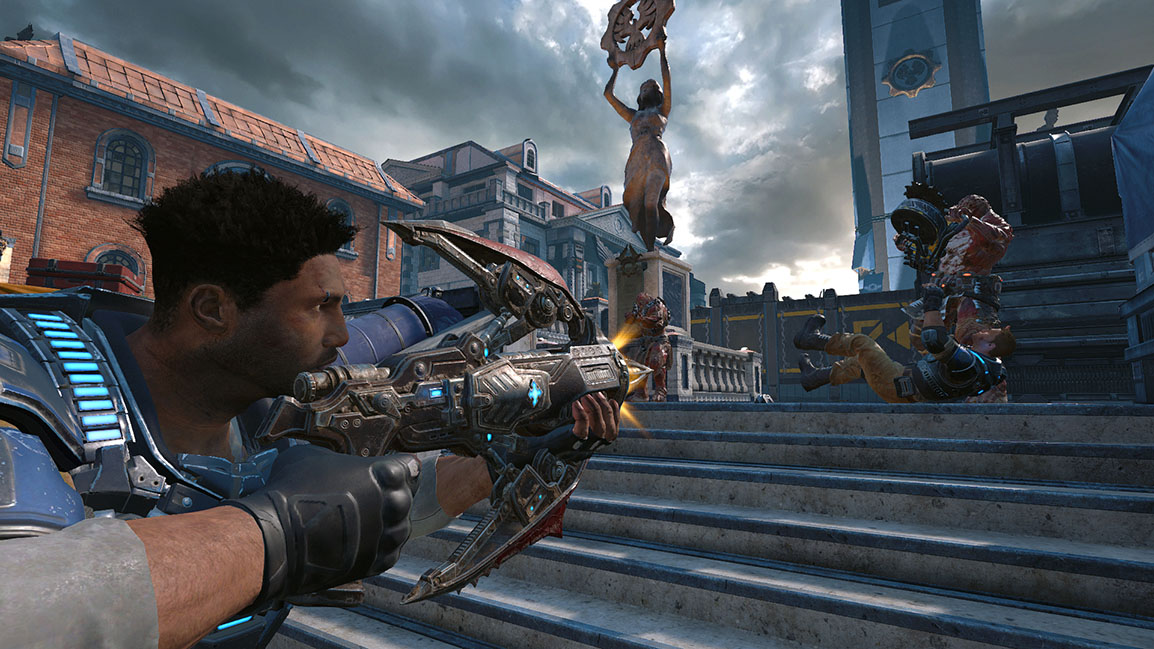 Versus Multiplayer
Versus Multiplayer
Signature, tier one Versus Multiplayer is back in Gears of War 4, this time in glorious 60 frame per second and pristine 1080p graphics (by comparison, the campaign and Horde mode run at 30 fps). The framerate bump up is immediately noticeable—the action in Versus Multiplayer feels fast and buttery smooth. Fans will be pleased to know that there are many favourite match types returning, including Team Deathmatch, King of the Hill, Guardian, and more. Joining them are some great new match types like the all-new Dodgeball that’s structured similar to its real-world counterpart: when you score a kill, you’ll also revive one of your fallen teammates. I love how in this mode puts pressure on team tactics, as just a single loss or two can turn your commanding lead into an even match. Another new mode I really enjoy is Arms Race, a match where teams compete to get three kills with a rotating list of 13 different weapons. For those tired of the all-too-common roll and Gnasher online match, this mode forces teams to use a variety of weapons, from the Boomshot all the way to the Boltok Pistol.
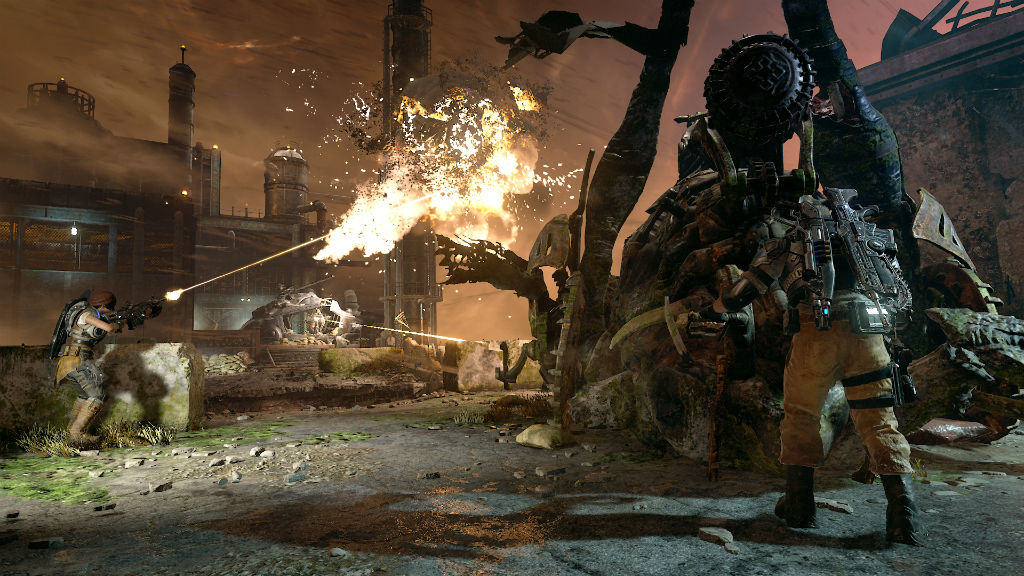 To accommodate gamers of all skill level, the Gears 4 Versus Multiplayer assigns each person a skill rank—Bronze, Silver, Gold, Onyx, and Diamond—after you’ve completed enough matches for the system to evaluate your results. This is a great inclusion as it means, in theory, you’ll always be matched up with players around your skill level. It also gives you motivation improve your game to rise in rank for personal glory, or to show off to your friends. The match types themselves are also bunched into Social, Competitive, and eSports playlists, so you can play at the skill level you feel most comfortable with. Without question, the Versus Multiplayer offering in Gears of War 4 is as solid in as it’s ever been, so if you’ve enjoyed this mode in previous games, you’ll almost certainly enjoy it just as much here.
To accommodate gamers of all skill level, the Gears 4 Versus Multiplayer assigns each person a skill rank—Bronze, Silver, Gold, Onyx, and Diamond—after you’ve completed enough matches for the system to evaluate your results. This is a great inclusion as it means, in theory, you’ll always be matched up with players around your skill level. It also gives you motivation improve your game to rise in rank for personal glory, or to show off to your friends. The match types themselves are also bunched into Social, Competitive, and eSports playlists, so you can play at the skill level you feel most comfortable with. Without question, the Versus Multiplayer offering in Gears of War 4 is as solid in as it’s ever been, so if you’ve enjoyed this mode in previous games, you’ll almost certainly enjoy it just as much here.
Final Thoughts
We may have been told this is a “new era” for Gears of War, but in reality what we’ve been given here is the core Gears experience built from the ground up on Microsoft’s latest gaming console. That’s not a bad thing at all—Gears of War 4 is phenomenal and fans of the series will undoubtedly enjoy what’s on offer here. The campaign is solid, Horde mode is in its greatest incarnation yet, and Versus Multiplayer is top-notch running at 60 fps, 1080p. Gears of War is back, as good as it’s ever been.
+ Exciting campaign with lots of high points
+ The best Horde mode yet
+ Exceptional multiplayer offering
+ Beautiful presentation
– Rookie heroes lack the presence of veteran characters
– Abrupt campaign ending
– Takes a lot of grinding to unlock Gears Cards
OVERALL
Gameplay: 4.5/5
Graphics: 4.5/5
Sound: 4/5
Lasting Appeal/Replayability: 4.5/5



